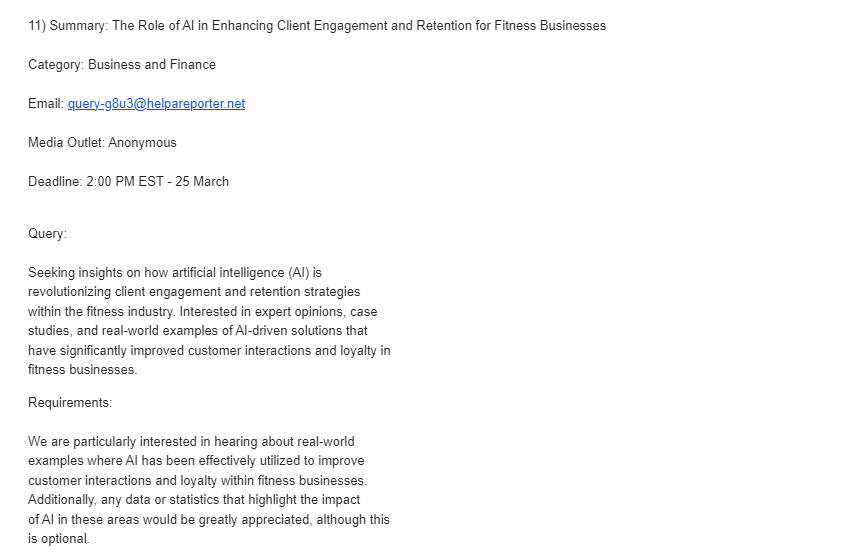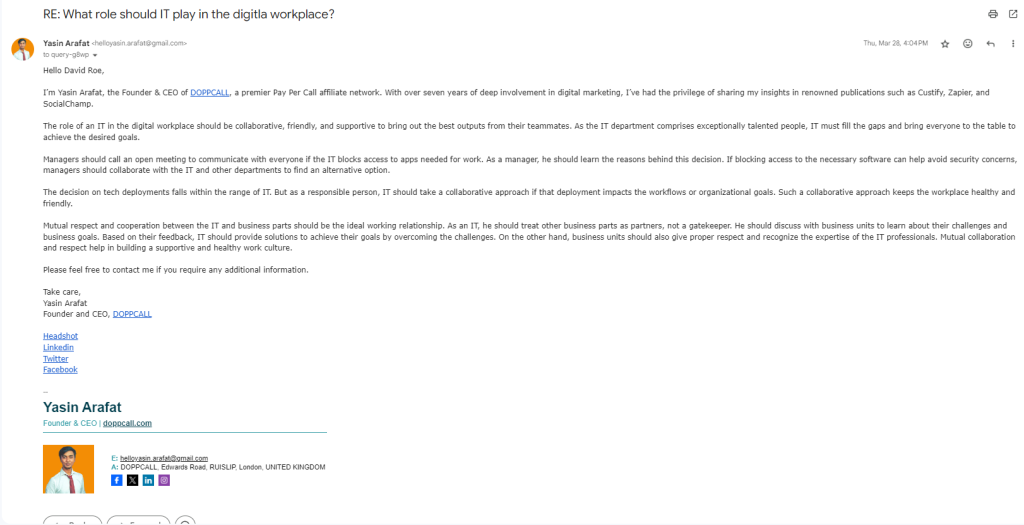Table of Contents

Building credibility, making connections, and getting your name out there require a lot of work. Building links to your site from other websites also takes a long time, and hiring someone else to do it for you is very expensive.
But there's a tool called HARO that can help you get exposure and build links at the same time. HARO stands for "Help A Reporter Out." Many reporters look on there when they need background information for stories. If they find your information helpful, they'll sometimes link to your website from theirs.
This can help get your name in front of more people for free. So, let’s explain how HARO works and how to get free links and press with it.
What Is HARO?
HARO stands for "Help A Reporter Out." It's a website that connects journalists with people who can give them information for their articles.
Peter Shankman created HARO back in 2008. He realized that reporters need to talk to regular people to learn about different topics. And those people want their knowledge and experiences to be shared.
HARO helps bring those two groups together. Over 75,000 journalists and bloggers use it regularly. There are over 1 million people signed up who can help with all sorts of topics.
Every day, HARO emails those people, listing questions from reporters. The emails say things like what publication the reporter works for, when they need the information, and how to contact them.
What is a HARO Query?
A HARO query is a request from a reporter looking for experts. The reporter sends the query to thousands in their field through HARO.

Experts, also called "sources," reply with information like quotes or by saying they can do an interview. The reporter uses these replies in their news story.
Not all reporters work for news outlets. Marketing writers also use HARO to find people to answer questions for their projects.
Some key parts of a query are:
What is a HARO pitch?
A HARO pitch is a source's reply to a reporter's question on HARO. The goal is to quickly give them helpful information.

A good pitch includes:
The HARO system automatically adds your profile info in #1. You provide the rest to best suit each query.
How Does HARO Work?
HARO is a tool for link-building that links journalists with potential sources for articles and interviews.
The first step to using HARO is to sign up for a free account on the HARO website. You can then use checkboxes to choose which types of questions you want to receive in your inbox. Besides, you can search for specific topics or media sources.
Each day, HARO will email you questions from reporters. You can look through them and pick ones relevant to your interests or expertise. If a question catches your eye, you can reply directly to the reporter. Here’s what you can include:
It's important to reply quickly since reporters are usually on tight deadlines. Try to keep your message short, helpful, and professional. Also, be careful not to spam reporters with generic pitches - answer what they asked clearly.
If the reporter likes your reply, they may contact you for an interview. You'll also find out when and where the article is published. This could include a backlink to your site. Getting mentioned this way builds your reputation and visibility online.
How to Use HARO to Get Free Links and Press
Getting started with HARO is easy. Just go to their website, fill out the signup form with your name and contact info, and pick the topics you know the most about.
Once signed up, you'll get emails with questions from reporters. You’ll then have to wait for the right opportunities. And when you see a question you can help with, keep these pitch tips in mind to get their attention:
Know What You're Good at
Reporters use HARO to find people with a lot of experience in their field. They don't want general answers, they want expertise. So, think about what you can talk about in-depth. This could be anything from marketing online to teeth whitening.
Before looking at questions, figure out exactly what topics you're an expert in. This will save you time later on. Once you know what you're good at explaining, finding the right questions is easy. You can get started straight away just by searching your email for keywords like "marketing" or "dog sitting."
Grab Their Attention with the Subject Line
Most reporters scan HARO responses pretty quickly. But they do look at the subject line before the details about who you are. And naturally, catchy subject lines make them want to read more than boring ones. It may not be the only reason they’ll choose a quote, but it will get them to look closer at your answer.
A good subject line sells you as an expert on that topic. For example, saying "Increase Your Email Open Rates" isn't that eye-catching, but something like "How I Increased Email Open Rates by 2%" sounds more interesting. It makes people curious to learn your tip.
Introduce Yourself Impressively
The subject line gets the reporter interested. Now, you need to keep their attention in your opening.
Write two short sentences (20-35 words) that tell why you're qualified. Say how long you've worked in this field, the types of companies you know about, and any certifications or achievements.
You can mention if your past interviews went well and give details that prove you're a true expert they can trust. When replying to a client, be sure to talk up their experience and credentials, too.
Do Your Research on the Reporter
All writers have their style, and so do HARO reporters. That’s why you’ll need to look at what they usually cover and how they write. Reporters also like things that sound familiar, so they'll be more likely to include your information if your response fits their style.
You can check the articles they've written for their sites. Get a feel for their tone and pay attention to the words and phrases they tend to use. Then, try including some of their typical phrases in your reply.
Also, search their stories to see if they have a track record of linking back to sources. Check if links are "dofollow" or "nofollow," too, since those matter for your website. For that, you can use this free tool.
Answer Only What They Ask for
Your HARO replies must not miss the point of the question. Reporters get tons of responses, so they skim fast, and replies that are not on topic only waste their time. If it keeps happening, you may get blocked from HARO.
Since so few answers are relevant, the ones that meet the question always stand out. Reporters want to use only those sources.
Also, don't just reply to part of what was asked either. Take the time to thoroughly answer everything the reporter questioned. These require work, so make sure you address all their points instead of getting ignored.
Keep it Short and Easy to Understand
Reporters have word limits for their articles, and they also need to cover multiple topics. That’s why you must be concise in your response. They may not count exact words but will notice long, dense blocks of text. So, if they asked for 100 words, don't go over.
Using simple, clear language is also essential, as most reporters don't have time to decipher complicated responses. If you send a long, wordy answer when a short one is requested, the reporter likely won't bother spending time trimming it down. They'll just move on to the next reply.
Follow the Reporter's Rules
So far, we have talked about one requirement only, which is word count. But there may be others, too. For example, some journalists only want responses directly from the experts and not from agencies. Others may ask for a photo or say no to promotions.
Read all guidelines and only reply if you can meet what they asked. You won't get featured if you don't follow their specific instructions.
Meanwhile, HARO also has its own rules to keep things fair, like:
Not obeying guidelines could get your response marked as spam. And that means reporters likely won't see it.
Add One Relevant Link
When joining HARO, include a link to your website homepage. This is shared with reporters seeing your profiles. Most often, just that homepage link is enough. Reporters usually only include one link per source they mention.
But if you have something else directly tied to answering the question, like a blog post on that topic, you can include one other link. Only do it if it truly provides useful context for the reporter. Don't add extra links. That doesn't help. Stick to one unless the homepage works fine by itself.
Include Examples from Your Own Work
What helps you get noticed in a sea of replies is showing off your skills. Notably, talking about real cases from your work proves your expertise.
Reporters will trust you more when they see examples of what you've achieved personally. It demonstrates that you truly know the topic inside and out. Personal stories also make your answer unique. Many replies just copy info from websites, which barely helps. But your own experiences stand apart from the rest.
Most journalists care about search engine rankings, too. They understand uniqueness helps with SEO, which makes your quote more useful for them.
Make Your Answer Easy to Import
Carefully review your response for typos before sending it. Have a coworker proofread it, too, if possible.
And as mentioned earlier, you’ll want to match the tone of the reporter's writing. So, trim away filler words to tighten up the text while keeping it well-punctuated.
The aim is to provide a quote the journalist can simply copy-paste into their article with little work. Just like in any sales process, reduce the barriers for them to choose your info.
Leave the Door Open for More Questions
Like a good sales page, end with a call to action. They won't do what you ask of them unless they know what you're asking.
You can say something as simple as, "Hope this helps! Let me know if you have any other questions." That short line works well most of the time. At this point, you don't need to add your info again since HARO has already shown it at the top.
Reporters can find your contact details in the mail. All you need to do is say you're available if they need something else.
Include Everything in Your Signature
Add all details a reporter could need upfront. This could be your name, job title, company, and headshots. This saves them the step of contacting you later.
Also, highlight the experience most relevant to their question. For example, if they asked for CEO perspectives, lead with "CEO" even if you have other roles.
Having the key info clearly displayed seals the deal. Reporters can immediately tell you're qualified without extra steps.
Share the Feature and Stay Connected
If a reporter uses your answer, share the article on your social networks. Most will send a ready-made post, so it's easy to share.
Journalists appreciate quick, polite sources. Sharing helps them and builds a relationship for next time. They'll remember you for future stories.
Also, ask to be tagged if the publication is promoted on social media. Reporters don't always decide that, but it can't hurt to ask.
HARO Pitch Mistakes You Should Avoid
When crafting your responses, a key thing you'll want to avoid is being overly promotional. Reporters are looking for genuine insight, not a sales pitch. But there are more things to be careful of. Such as:
1. No Document Attachments
For security reasons, HARO deletes any replies with attachments. This protects reporters from possible viruses. Instead of attaching files, upload documents to services like Google Drive. Then, include the file links in your response.
Links are safer than attachments and allow reporters access if they need more details. Just be sure files are publicly available without the required logins.
2. Stick to Your Own Specialty
Similar topics can often blend, but your expertise has limits. For example, the finance tech and financial advising areas may sometimes overlap. But a dental question is too far away from finance. Responding to related queries is okay, but don't push it by replying to entirely different specialties.
3. Don't Copy or Use Fake, AI-Generated Replies
Reporters constantly research topics, and they can easily spot plagiarized answers. They just know what else is out there. Besides, passing off others' work as your own can get you blocked from seeing a journalist's questions in the future. Then, too many blocks, and you may also lose HARO access for good.
Creating fake responses with AI tools is questionable, too, as search engines may flag AI-generated text. While AI can spark ideas, sending those machine copies as is isn’t a good idea. If you need to use AI anyway, be sure to edit the output in your own words to make it sound real.
4. Don't Rush, Send Your Best Work
While replying right away is good since reporters may pick faster sources, it's still better to take time crafting a high-quality, carefully written response. After all, reporters will always choose well-thought-out pitches over speedy ones.
You can expect to get results no matter when your response arrives as long as it’s useful and well-made. So, don't hurry and lower your standards. Take the time needed to make your answer as strong as possible within the guidelines.
5. Templates Are OK, but Add Your Own Touch
Templates can help you reply faster by providing a format. But don't just send the identical template to every reporter. Customize each response to sound more human. Since reporters get a lot of generic templated replies, writing your own words for each answer increases the chance it will stand out.
Templates for HARO Pitches
Here, we’ve shared two templates you can use for your HARO pitches.
1. Interview Request Template for HARO:
Hi [Reporter's Name],
My name is [Your Name], and I'm the [Your Title] at [Company]. I've been in [industry/field] for [years] and have experience with [topics].
I'm available at [time] to further discuss [reporter's question/topic]. I can also share [examples of past work or a short bio] if helpful.
Let me know if you'd like to chat! If that time doesn't work, I'm flexible too.
Thank you for your time. Hope to hear back!
[Your Name]
[Your Title]
[Company]
[Your LinkedIn profile]
2. Quote Request Pitch Template from HARO:
Hi [Reporter's Name],
I'm [Your Name], the [Your Role] at [Company]. I've worked in [industry/field] for [years].
Here is my response to your HARO question:
[Pitch Response]
Please feel free to contact me if you have any other questions. I’m happy to discuss this further.
Thank you for your consideration.
[Your Name]
[Your Title]
[Company]
Frequently Asked Questions
What is a good HARO pitch length?
Ideally, you’ll want to check the reporter's question for any word count they mentioned. If they didn't specify, keep it manageable at around three short paragraphs or so. That's about 300 words. Reporters are busy, so keeping it short is best. But make sure to fully answer what's asked, too.
How long does it usually take to write a pitch on HARO?
Plan for around 20 minutes per pitch. That allows time to think through the question, craft your answer, and give it a quick proofread. Requests outside your specialty may take a bit more thought. But be sure to say just what's needed to fully answer the question.
Should I write a pitch for Anonymous HARO queries?
You can reply to anonymous queries if you like. Sometimes, big brands use anonymous queries so sources don't spam them. As long as the question seems legit and asks for real info, not links or ads, you can go ahead. Just be aware the reporter's name is hidden.
Conclusion
HARO can help businesses get noticed through articles and build quality backlinks. Getting quoted in published articles feels great and exposes your business to new readers. It's a smart way to gain visibility and trust.
Using HARO is very affordable compared to other promotion methods. All it takes is your time to thoughtfully answer questions. Quality connections with journalists lead to more opportunities over time.
Your expertise and insights can reach a wider audience through the articles they produce. More traffic and links naturally come back to your website, too. So, always give helpful responses whenever you see a relevant query. As you gain experience, HARO can really boost your online profile in an honest, natural way.




Leave a Reply